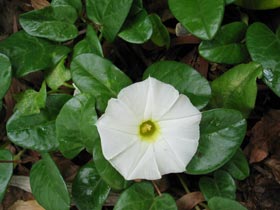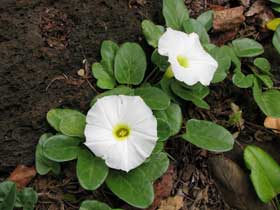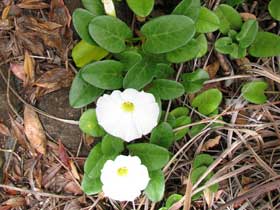Ipomoea imperati
Genus
Ipomoea
Species
imperati
Hawaiian Names with Diacritics
- Hunakai
Hawaiian Names
- Hunakai
Common Names
- Beach morning glory
- Beach morning-glory
Synonyms
- Convolvulus imperati
- Convolvulus stoloniferus
- Ipomoea acetosaefolia
- Ipomoea fauriei
- Ipomoea littoralis
- Ipomoea stolonifera
Distribution Status
Indigenous
Endangered Species Status
No Status
Plant Form / Growth Habit
- Non-Woody, Spreading
- Vine/Liana
Mature Size, Height (in feet)
- Herbaceous, Short, Less than 1
Mature Size, Width
Hunakai has a 30-foot spread.
Life Span
Long lived (Greater than 5 years)
Landscape Uses
- Accent
- Ground Cover
Additional Landscape Use Information
Give this vine plenty of room to spread. Hunakai is easy to grow and maintain in the landscape and stays very low to the ground. They can sometimes be passively aggressive and seem to pop up here and there in the landscape. This native morning glory looks very nice when grown in black cinder, coral rock, or sandy areas. [David Eickhoff, Native Plants Hawaiʻi]
Source of Fragrance
- No Fragrance
Plant Produces Flowers
Yes
Flower Type
Showy
Flower Colors
- White
- Yellow
Additional Flower Color Information
Hunakai has bright white flowers with a yellow, occasionally purple, throat.
Blooming Period
- Year Round
Plant texture
- Fine
- Medium
Additional Plant Texture Information
Leaf sizes range from one half inch to over 2 inches long. The glabrous (dull) leaves are variable and are oblong, oval and sometimes forming two or three lobes. [David Eickhoff, Native Plants Hawaiʻi]
Leaf Colors
- Light Green
- Medium Green
Additional Pest & Disease Information
Hunakai is prone to the sweet potato weevil and the red spider mites.
Fertilizer
An application of a balanced slow release fertilize with minor elements every six months. Foliar feed monthly with kelp or fish emulsion, or a water-soluble fertilizer with a dilution of one half to one third of recommended strength. [David Eickhoff, Native Plants Hawaiʻi]
Pruning Information
Hunakai might be described as passively aggressive and it is not necessary to prune unless invading nearby planting beds.
Water Requirements
- Dry
Additional Water Information
Once plants are well established, water only in times of prolonged drought. Very drought tolerant.
Soil must be well drained
Yes
Light Conditions
- Full sun
Additional Lighting Information
Hunakai does not do well in shaded conditions and appear to lessen flower production.
Tolerances
- Drought
- Brackish Water
- Wind
- Salt Spray
- Heat
Soils
- Sand
- Cinder
- Coral
Natural Range
- Niʻihau
- Kauaʻi
- Oʻahu
- Molokaʻi
- Maui
Natural Zones (Elevation in feet, Rainfall in inches)
- Less than 150, 0 to 50 (Dry)
Additional Habitat Information
Hunakai is found on beaches and sand dunes.
![]() Special Features and Information
Special Features and Information
General Information
Hunakai (Ipomoea imperati) is a member of the Morning glory family (Convolvulaceae), which comprises some 1,650 species throughout the world.
Hunakai is related to some local notable eatables as ʻuala or sweet potato (Ipomoea batatas) and ung-choi or swamp cabbage (Ipomoea aquatica).
Native Hawaiian family members include a bonamia (Bonamia menziesii), makihi (Cressa truxillensis), koali ʻai (Ipomoea cairica), koali ʻawa (I. indica), Hawaiian moon flower (I. tuboides), pōhuehue (I. pes-caprae subsp. brasiliensis), kauna ʻoa (Cuscuta sandwichiana), pāʻuohiʻiaka (Jacquemontia ovalifolia subsp. sandwicensis), and the possibly indigenous White-flowered beach morning glory (Ipomoea littoralis).
Etymology
The generic name Ipomoea is derived from the Greek ips, worm, and homoios, similar to, meaning worm-like, in reference to the twining habit.
The specific epithet imperati is derived from the Latin imperatus, ruler or emperor.
Hawaiian Name:
The Hawaiian name Hunakai means "sea foam" which is appropriate for its shoreline habitat. This name is also shared by the sanderling (Calidris alba), a migratory shorebird that quickly runs along the receding waves on sandy shores in search of small edible creatures. [1] This habit of these tiny birds apparently reminded the early Hawaiians of the sea foam or hunakai left behind by the waves.
Background Information
Additional References
[1] "Hawaiʻi's Birds" (Hawaii Audubon Society), page 54.
PHOTOS FOR THIS SPECIES CAN BE SEEN AT THE LINK (Copy & Paste to your browser):
https://www.flickr.com/search/?user_id=50823119%40N08&sort=date-taken-desc&text=Ipomoea%20imperati&view_all=1
Plant Gallery
Back to Plant List
Other Nursery Profiles for Ipomoea imperati



